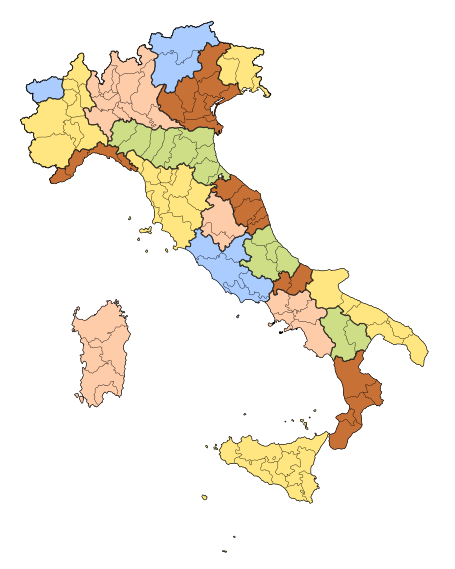Traditions of Italy
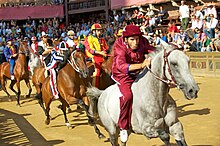
| Part of a series on the |
| Culture of Italy |
|---|
 |
| People |
| Traditions |
Traditions of Italy are sets of
Overview
Christmas

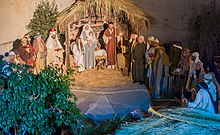
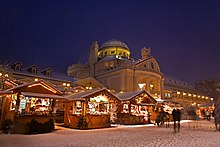
The tradition of the
In southern Italy, living nativity scenes (presepe vivente) are extremely popular. They may be elaborate affairs, featuring not only the classic nativity scene but also a mock rural 19th-century village, complete with artisans in traditional costumes working at their trades. These attract many visitors and have been televised on RAI, the national public broadcasting company of Italy. In 2010, the old city of Matera in Basilicata hosted the world's largest living nativity scene of the time, which was performed in the historic center, Sassi.[10]
The tradition of the
In Italy, the oldest
Typically Italian tradition is instead that of the zampognari (sg.: Zampognaro), or men dressed as shepherds and equipped with zampogna, a double chantered bagpipes, who come down from the mountains, playing Christmas music.[21] This tradition, dating back to the 19th century, is particularly widespread in the South of the country.[22] A description of the Abruzzese zampognari is provided by Héctor Berlioz in 1832.[21]
Typical bearers of gifts from the Christmas period in Italy are Saint Lucy (13 December), Christ Child, Babbo Natale (the name given to Santa Claus), and, on Epiphany, the Befana.[23]
According to tradition, the Christmas Eve dinner must not contain meat. A popular Christmas Day dish in
Easter
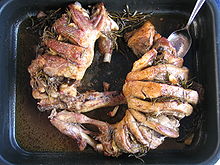
In Versilia, as a sign of forgiveness, but this time towards Jesus, the women of the sailors kiss the earth, saying: "Terra bacio e terra sono - Gesù mio, chiedo perdono" ("I kiss the earth and earth I am - my Jesus, I ask for forgiveness").[33] In Abruzzo, however, it is the custom of farmers during Easter to add holy water to food.[33] Holy water is also used in Julian March, where half a glass is drunk on an empty stomach, before eating two hard-boiled eggs and a focaccia washed down with white wine.[33]
Another symbol used during the Easter period is fire. In particular, in
In
The
New Year's Eve

In Italy,
Patron saint festivals
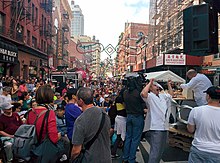
The Italian national patronal day, on 4 October, celebrates Saints Francis and Catherine. Each city or town also celebrates a public holiday on the occasion of the festival of the local patron saint,[40] for example: Rome on 29 June (Saints Peter and Paul), Milan on 7 December (Saint Ambrose), Naples on 19 September (Saint Januarius), Venice on 25 April (Saint Mark the Evangelist) and Florence on 24 June (Saint John the Baptist). Notable traditional patronal festivals in Italy are the Feast of Saints Francis and Catherine, the Festival of Saint Agatha, the Feast of Saints Peter and Paul, the Feast of San Gennaro and the Feast of Our Lady of the Hens.
Carnival
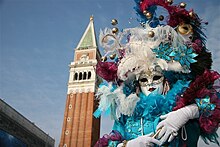
Where the
Sagre
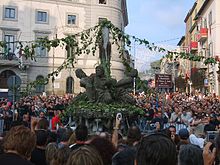
In Italy, a sagra (plural: sagre) is a popular festival of a local nature and annual frequency, which traditionally arises from a religious festival, celebrated on the occasion of a consecration or to commemorate a saint (usually the patron saint), but also used to celebrate the harvest or promote a food and wine product local.[42] During a festival the local fair, the market and various celebrations usually take place.[42]
A sagra is often dedicated to some specific local food, and the name of the sagra includes that food; for example: Festival delle Sagre astigiane, a Sagra dell'uva (grapes) at Marino, a Sagra della Rana (frog) at Casteldilago near Arrone, a Sagra della Cipolla (onion) at Cannara, a Sagra della Melanzana ripiena (stuffed eggplant) at Savona, a Sagra della Polenta at Perticara di Novafeltria, a Sagra del Lattarino at Bracciano, a Sagra del Frico at Carpacco-Dignano and so on. Among the most common sagre are those celebrating olive oil, wine, pasta and pastry of various kinds, chestnuts, and cheese.
Ferragosto
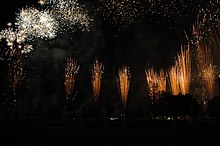
Historical competitions
Historical competitions are widespread throughout the Italian national territory, such as the Palio, the name given in the country to an annual athletic contest, very often of a historical character, pitting the neighbourhoods of a town or the hamlets of a comune against each other. Typically, they are fought in costume and commemorate some event or tradition of the Middle Ages and thus often involve horse racing, archery, jousting, crossbow shooting, and similar medieval sports.[44] The Palio di Siena is the only one that has been run without interruption since it started in the 1630s and is definitely the most famous all over the world.[45]
Traditional events

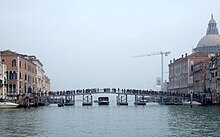
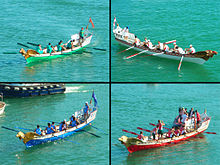
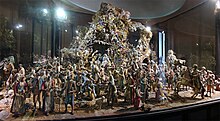

- The
- The Venetian Istria) and Dalmatia (Venetian Dalmatia).[50] Istria today is part of Slovenia and Croatia, while Dalmatia belongs to Croatia. The number of local ethnic Italians in Istria and Dalmatia (Istrian Italians and Dalmatian Italians) dropped dramatically afterwards the Istrian–Dalmatian exodus. In Venice, the pilgrimage of the festival has as its destination the basilica of Santa Maria della Salute. Throughout the day, in the basilica, which is kept open without interruption, masses and rosaries are celebrated continuously, with a continuous influx of faithful. To facilitate the pilgrimage, a temporary wooden bridge was erected on the Grand Canal connecting from Santa Maria del Giglio to the vicinity of the basilica.[51] In Veneto, Our Lady of Health is celebrated in many municipalities, including those not belonging to the province of Venice, and almost always falls on 21 November. Some municipalities that celebrate the event are Dolo, Este, Cavaso del Tomba and Camposampiero. In the province of Trieste and in the capital itself it is also celebrated on 21 November. In Emilia-Romagna, in the municipality of Solarolo, where there is also a sanctuary dedicated to Our Lady of Health, a participatory religious function is celebrated in her honor in September.[52] In Sardinia the festival is particularly felt by the community of Gonnosfanadiga, where it has been considered one of the main festivals of the town since its inauguration in 1849.[53] It is celebrated on the last Sunday of May, and the events last for several days.[53] It is celebrated in other Sardinian towns on different dates, such as in Pozzomaggiore, Masainas and Villanovafranca, during the last weekend of September. In Ittiri, where Our Lady of Health is celebrated as the patron saint of traders, the festival is held at the beginning of September.[54] In Calabria, in Amendolara and more particularly in the hamlet of Amendolara Marina, there is the parish dedicated to Our Lady of Health, whose feast is celebrated in August.[55]
- The procession from Fontainemore to Oropa (Italian: Processione da Fontainemore a Oropa) is a Marian procession that takes place every five years and during which the faithful of the Valle d'Aosta town of Fontainemore make a pilgrimage to the Sanctuary of Oropa crossing at night the Biellese Alps. It is one of the oldest documented processions in the Alps.[56] The first documentary records of the procession date back to 1547,[57] although according to some scholars the pilgrimage would have started to take place in even more ancient times.[58] In the procession, in which once only the faithful of the small Aosta Valley town (which today has a few hundred residents) took part, today there are also many other people from the rest of the Aosta Valley, from the Biella area (Piedmont) or even further away, so that there can be thousands of pilgrims.[59]
- The Angelo Roncalli (later elected Pope John XXIII).[61] The first edition took place in Pisa on 1 July of that year; among those present stood out in particular the President of Italy Giovanni Gronchi and the Minister of Merchant Navy Gennaro Cassiani.[62]
- The feast of Saints Francis and Catherine is a religious and civil celebration annually held on 4 October in Italy and in general Christians of Italian ancestry[63] in honour of Francis of Assisi and Catherine of Siena, patron saints of Italy.
- The Saint Paul, which is observed on 29 June. The feast is observed in Rome because St. Paul and St. Peter are patron saints of the Eternal City.[64] In the Apulia region of southeastern Italy, the feast was associated with the Tarantella dance since the Middle Ages. It was believed that the bite of the tarantula wolf spider caused a form of manic behavior which would result in death if the afflicted did not dance and could not be cured without the intercession of saint Paul. These panics were especially common near the feast day in the 16th and 17th centuries in Galatina, where the basilica of Saint Peter and Paul is located.[65]
- In Italy, the oldest Brunico.[14] The Trento Christmas market, established in 1993, is renowned in Trentino.[15] In Naples, where the tradition of the Neapolitan nativity scene has been famous for centuries, the exhibition of the nativity scenes made in the city's artisan shops is held every year in via San Gregorio Armeno.[16]
- In Italy
- The feast of Saint John the Baptist has been celebrated in Florence from medieval times, and certainly in the Renaissance, with festivals sometimes lasting three days from 22 to 24 June.[68] Such celebrations are held nowadays in Cesena from 21 to 24 June also with a special street market. Saint John the Baptist is the patron saint of Genoa, Florence and Turin where a fireworks display takes place during the celebration on the river. In Turin Saint John's cult is also well-established since medieval times when the city stops work for two days and people from the surrounding areas gather to dance around the bonfire in the central square. In Genoa and coastal Liguria it is traditional to light bonfires on the beaches on Saint John's Eve to remember the fires lit to celebrate the arrival of Saint John's relics to Genoa in 1098.[69] Since 1391 on 24 June a great procession across Genoa carries the relics to the harbour, where the Archbishop blesses the city, the sea, and those who work on it.
Abruzzo
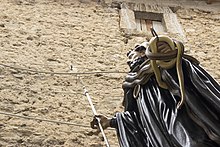
- The Celestinian Forgiveness (Italian: Perdonanza Celestiniana) is a religious and historical annual event held in L'Aquila, Italy, at the end of August. It is a catholic jubilee celebration, established in 1294 by pope Celestine V with his bull Inter sanctorum solemnia (also known as Bull of Pardon or Bull of Forgiveness).[70] Since 2011 the celebration is a "Heritage of Italy for tradition" ("Patrimonio d'Italia per la tradizione")[71] and in 2019 it was inscribed in the UNESCO Representative List of the Intangible Cultural Heritage of Humanity.[72]
- The St. Dominic, patron saint protecting against snakebite and toothache.[73] Its origins date back to paganism and have roots in an ancient celebration in honour of the Roman goddess Angitia.[74]The festival involves a procession carrying the statue of St. Dominic, draped with living snakes, through the streets of the village.
Apulia

- The Notte della Taranta (English: Night of Taranta) is a music festival in Salento, Apulia, Italy. The Night of Taranta is focused on Pizzica, a popular folk genre in Salento, and takes place in various municipalities in the province of Lecce and the Grecìa Salentina, especially in Melpignano. It gives great importance to the folk music tradition of Taranta and Pizzica, and it is a resource for tourism in Apulia.[75] The festival tours around Salento, normally culminating in a grand finale concert in Melpignano in August, which lasts until late night. An average of 200,000 spectators attend the last concert every year.[76] The festival started in 1998 by an initiative of several municipalities of the Salento, which sponsored the event. Every year a new musical director is chosen.
- The rites of the Holy Week in Ruvo di Puglia are the main event that takes place in Ruvo di Puglia. Folklore and sacred or profane traditions, typical of the ruvestine tradition, represent a great attraction for tourists from neighboring cities and the rest of Italy and Europe,[77] and have been included by the Central Institute for Intangible Heritage among the events of the intangible heritage of Italy.
Basilicata

- The The path measures a total of about one kilometer and a series of grotto cavities welcome visitors in groups, serving as a location for the historical re-enactment of the most significant biblical passages related to the birth of the Lord.
- The Carnival of Satriano (Italian: Carnevale di Satriano), held in Satriano di Lucania, Italy every February, is one of the country's many carnivals.[80] Held on the Friday, Saturday and Sunday before Fat Tuesday (a Mardi Gras festival), it has been conducted for centuries.[81] The event is among the most important carnival traditions of the region and of Italy and it is unique in that participants wear costumes, or masks,[80][82] of bears, hermits, or lent.[81]
Calabria
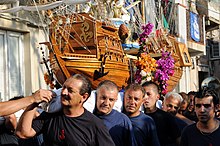
- The
Campania
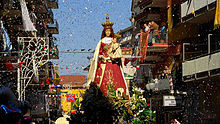
- The feast of Saint Mary the Crowned of Carmel, commonly known as Feast of Our Lady of the Hens (Italian: Madonna delle Galline), is a religious and civil festival annually celebrated in Pagani, Campania on the second Sunday of Easter. At dawn on Monday, the tammorrari, engaged for three days and three nights to play and dance in the toselli, go in procession to the sanctuary, where they deposit their instruments at the feet of the Virgin and, thanking her, make an act of submission, and then, without ever turning your back to the altar, leave the sanctuary singing the ancient popular song Madonna de la Grazia.[87]
- The caffè sospeso (Italian for 'suspended coffee'; pronounced [kafˈfɛ ssoˈspeːzo; -eːso]) or pending coffee is a cup of coffee paid for in advance as an anonymous act of charity. The tradition began in the working-class cafés of Naples, where someone who had experienced good luck would order a sospeso, paying the price of two coffees but receiving and consuming only one. A poor person enquiring later whether there was a sospeso available would then be served a coffee for free.[88][89] Coffee shops in other countries have adopted the sospeso to increase sales, and to promote kindness and caring.
- The Neapolitan songs that occurs on 8 September in Piedigrotta, Naples. It was officially inaugurated on 8 September 1839, with the victory of the song Te voglio bene assaje.[90] In addition to listening to the songs in the competition, the event gave ample space to tarantella and macchiette based on traditional instruments, such as putipù, triccheballacche, castanets or on those called "'e scucciamienti" used to rumbling furiously.[91]
- The calendar of the Catholic Church.[a][94][95] In Naples and neighboring areas, an annual celebration and feast of faith held is over the course of three days, commemorating Saint Gennaro. Throughout the festival, parades, religious processions and musical entertainment are featured.[96][97] In the United States, the "Festa of San Gennaro" is also a highlight of the year for New York's Little Italy, with the saint's polychrome statue carried through the middle of a street fairstretching for blocks.
Emilia-Romagna
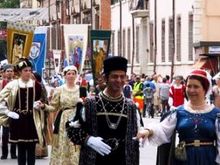
- The Palio of Ferrara (Italian: Palio di Ferrara) is a competition among the 8 neighborhoods (contrade) of the town of Ferrara, Emilia-Romagna, Italy. Four of these neighborhoods correspond to four wards located inside the medieval town fortifications. The remaining four correspond to external boroughs. The Palio is an historical reenactment based on 1259 celebrations for the return from Rome of Borso d'Este after receiving the duchy investiture from Pope Paul II. The celebrations were repeated regularly until around 1600. After a long interruption the tradition was briefly reenacted in 1933, stopped again during World War II and eventually restarted in 1967.[98][99][100][101]
- The Carnival of Cento (Italian: Carnevale di Cento) is a historic carnival that takes place in Cento, in the province of Ferrara. The Carnival in Cento has ancient origins, as evidenced by some frescoes by the 17th-century painter Giovanni Francesco Barbieri known as Guercino, which portray scenes of the festivities and carnival celebrations in the city. Since 1990 the event has become an important folkloric event, thanks to the twinning with the Rio Carnival where masks of the previous edition's winning float paraded for a few years and to the constant presence of Italian and international entertainment characters.[102]
- The Palio di Parma is a festival that is held once a year in the northern Italian town of Parma, and traces back to the ancient "Scarlet Run"".[103] The origin of this festival can be reconducted to 1314[104] as reported by Giovanni Del Giudice in the Chronicon Parmense.[105] The festival was held every year on 15 August, from the 14th century to Napoleon's arrival in the 19th century.[106] Starting from 1978 the competition was brought to a new life.[104]
Friuli-Venezia Giulia
- The Guinness World Record holder in February 2019 when it was named "the greatest sailing race" with its 2,689 boats and over 16,000 sailors on the starting line.[107] Thanks to its particular formula, the Barcolana is a unique event on the international sailing stage: on the same starting line expert sailors and sailing lovers race side by side on boats of different sizes divided into several divisions according to their overall length.[108]
Lazio
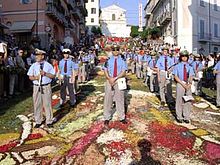

- 6 January is celebrated the Epiphany in Rome. It is a religious event that, as often happens, over time has become an opportunity to spend a day with the family, thanks also to the most popular and pagan figure of the Befana, who delivers gifts, candies or coal to the little ones. What soon became the Festa della Befana ("Feast of the Befana") sees its epicenter in the capital and in particular in Piazza Navona, where many stalls with traditional socks full of sweets are housed.[109]
- The ancient Romans, the carnival was one of the main celebrations of papal Rome.[110] The main mask of the Roman carnival is Rugantino, but there are also various Roman Norcini, Aquilani, Facchini and Pulcinelli[111] as well as Meo Patacca, General Mannaggia La Rocca, the credulous noble Cassandrino, Don Pasquale de 'Bisognosi, the puppeteer Ghetanaccio (18th century character represented with the theater on his shoulders), Doctor Gambalunga (depicted with large glasses, black tunic and book in hand) and the Gypsy.[112]
- The festa de Noantri (Romanesco dialect for 'feast of us others', as opposed to "you others who live in other neighborhoods") is a Christian religious festival that is celebrated in honor of the Blessed Virgin of Carmel from 16 to 30 July, on the occasion of its liturgical feast, in the Trastevere district of Rome. The origins of the festival seem to date back to 1535: it is in fact handed down that after a storm, a statue of the Virgin Mary, carved in cedar wood, was found at the mouth of the Tiber by some Corsican fishermen. The Madonna, for this reason called "Madonna Fiumarola", was then donated to the Carmelites (to whom the title "Madonna del Carmine" is owed), of the Basilica of San Crisogono in Trastevere; she thus became the patron saint of the people of Trastevere.[113]
- The Castelli Romani, the custom of preparing flower carpets for the Feast of Corpus Christi had existed for some time. The tradition was born in Rome in the first half of the 17th century and had been adopted in the localities of the Alban Hills probably due to the close ties of this territory[114] with Gian Lorenzo Bernini, the main architect of Baroque celebrations.[115]
- The macchina di Santa Rosa (English: machine of Santa Rosa) is a 30-metre-high (98 ft) machine built to honor Saint Rose of Viterbo, the patron saint of Viterbo, Italy. Every year on the evening of 3 September 100 men called "Facchini di Santa Rosa" (Saint Rose's porters) hoist the machine - weighing about 11,000 pounds (5,000 kg) - and carry it through the streets and squares of Viterbo's medieval town centre. The whole route is slightly longer than 1 km (1 mi). The machine is rebuilt anew about every five years. The machine's procession is a significant event in Viterbo, attracting thousands of spectators, and is included in the UNESCO Representative List of the Intangible Cultural Heritage of Humanity.[116]
Liguria
- The Palio del Golfo is a rowing challenge that is held every year, on the first Sunday of August, in the sea of the Gulf of La Spezia. The Palio is part of the La Spezia sea festival, and the boats of the 13 seaside villages that overlook the Gulf of La Spezia participate. The palio was held for the first time in 1925, when the coastal resorts of the gulf challenged each other in a rowing competition made with boats normally used for sea fishing. According to the chronicles of the time, however, it seems that already in 1878 a similar event took place on the occasion of the launch of the royal ship Dandolo.[117]
- The Palio Marinaro di San Pietro is a sporting event of historical re-enactment, established in 1955 in Genoa.[118] There are 12 districts that challenge in the regatta: Sant'Ilario (Purple), Nervi (Orange), Quinto (Light blue), Quarto (Gray), Sturla (Yellow), Vernazzola (Dark blue), Foce (Red / Blue ), Centro Storico (White / Yellow), Dinegro (White / Blue), Sampierdarena (White / Green), Sestri Pontente (White / Black) and Voltri (Green).
Lombardy
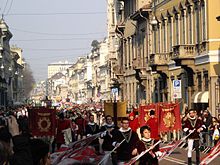
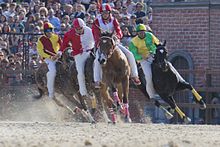

- The
- Sforza Castle. The most typical goods that are sold at Oh bej! Oh bej! are sweets and Christmas or winter delicacies, handcrafts such as Christmas decorations, toys, antiques, souvenirs, bric-a-brac, and more.[124] The fair is usually very crowded; this is partly because, as Saint Ambrose Day is immediately followed by the Immaculate ConceptionDay (an Italian national holiday), and this in turn might be followed by a week-end, Milanese usually have several free days in the fair's days.
- Santa Maria al Paradiso, in the surroundings of Porta Vigentina, is associated to the legend.
- The horse race. Until 2005 the whole event was named Sagra del Carroccio.[129] Legnano is subdivided into eight contrade, each of which takes part both in the medieval pageant and in the horse race held at the stadio Giovanni Mari. This is considered one of the most important non-competitive events of this type in Italy. In 2003 the historic pageant was shown at the Columbus Day in New York City.[130] A lot of Palio-centric events take place in Legnano during May and July, such as the choral exhibition La Fabbrica del Canto ('The factory of singing') born in 1992 from an idea of the musical association Jubilate.[131] In 2015, institutions made 29 May a holiday for the whole of Lombardy.[132]
- The Prima della Scala ("Saint Ambrose, patron saint of the city, at the La Scala theater to inaugurate the opera season.[133] This cultural event attracts the presence of important Italian institutional offices such as the President of Italy and the Prime Minister of Italy.[133][134] It is also a highly appealing social event that attracts important personalities from the world of culture, politics, fashion and entertainment.[133] The current practice of inaugurating the opera season on 7 December was introduced in 1940 and then, permanently, at the behest of Victor de Sabata, starting from 1951.[135] On 7 December 1940, Maria Callas, who had made her debut on the Milanese stage a few months earlier, obtained her first Milanese triumph singing in I vespri siciliani directed by De Sabata himself.[136] The season premiere at La Scala is both a cultural, institutional and worldly event deeply rooted in Italian life.[137] Since 2008, the opening night has been preceded by the "youth preview", a recital of the inaugural opera dedicated to the public under the age of 30.[138] In 2022, the president of the European Commission also attended the La Scala season premiere.[139]
Marche
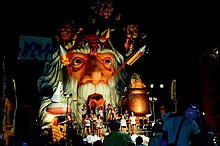
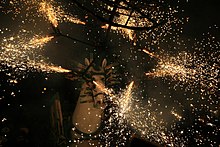
- The Carnival of Fano (Italian: Carnevale di Fano) is one of the oldest carnivals in Italy together with that of Venice.[140] It takes place annually between February and March in Fano. The first documents of the carnival of Fano date back to 1347, regarding the setting up of the "Palio Carnevale", even if the historian Vincenzo Nolfi[141][142] places its birth from the reconciliation between the Guelph family of Cassero and the Ghibelline Da Carignano, cited by Dante Alighieri in the Divine Comedy.[143] The origin of this festival could be even earlier. The carnival could in fact derive from the ancient Roman feasts of the Saturnalia and from the ancient Greek Dionysia characterized by the presence of "rice" and satire as a fundamental element of the festival.[144] The carnival in Fano had a great momentum when in 1450 the Malatesta family strongly promoted it. Gradually this festival became more and more important and more and more sumptuous.[145]
- The Virgin Mary, the local dwellers hired a pyrotechnicianwho, once the spectacle was over, took all his remaining fireworks and shot riding his horse. This extemporized action struck the citizens who began to recall it yearly. In the 18th century a mock steed replaced the animal and the fireworks were assembled upon it.
- Holy House.[146] On the night of the vigil, between 9 and 10 December, in all the Marche and most of Umbria, especially in the Valnerina, there is a living tradition of lighting large bonfires (focaracci or fogaró) to "light the way to the Holy House";[147][148][149] these are the fires of the night of the Venuta, meaning the arrival of the Holy House. The fires are lit at the first shadows of evening in the countryside, towns and cities, including the capital, Ancona,[150] where the various districts compete to set up the highest and most beautiful fire. When the fires are low, the children throw firecrackers and flares and challenge each other to jump across the embers, traditionally nine times.[151]
- The Quintana di Ascoli Piceno is a historical re-enactment of medieval origin with an equestrian joust held in Ascoli Piceno in the Marche region. There are 2 editions of the game, one in July and the other in August. The July edition is dedicated to the Virgin of Peace and takes place on the evening of the second Saturday in July, while the August edition takes place on the afternoon of the first Sunday in August on the occasion of the feast of Emygdius, patron saint and first historically attested bishop. of the city.[152]
Molise
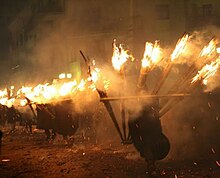
- The Ndocciata is an ancient Christmas festival celebrated in Molise, southern Italy, specifically in the city of Agnone. On the evening of 24 December the Ndocciata of Agnone is a parade of a great number of torches (Molisan: ndocce), structures with a typical fanwise shape, made of silver fir pinewood pallets.[153] They may be only one torch or, more often, with multiple torches up to 20 fires. Four metres high, ndocce are transported by different carriers dressed in traditional costumes. The big bell of St. Anthony's Church is rung, and groups from the cities' districts (Capammonde and Capabballe, Colle Sente, Guastra, Onofrio, San Quirico) consisting of hundreds of carriers of all ages, light their ndocce (torches) to set off along the main streets which thus becomes what locals call a "river of fire." There is a choral participation and bagpipers along the roads of the village, and groups compete in order to have the biggest and the most beautiful ndocce. The procession ends with a bonfire called "Bonfire of Brotherhood" at Plebiscite Square where a Nativity scene is displayed.[154]
Piedmont

- The William VII of Montferrat.[157] This tyrant attempted to rape a young commoner (often specified as a miller's daughter[158]) on the evening of her wedding, supposedly exercising the droit du seigneur. The tyrant's plan backfired when the young woman instead decapitated him, after which the populace stormed and burned the palace.[159] Each year, a young girl is chosen to play the part of Violetta, the defiant young woman.[155][160]Every year the citizens remember their liberation with the Battle of the Oranges, where teams of aranceri (orange handlers) on foot throw oranges (representing old weapons and stones) against aranceri riding in carts (representing the tyrant's ranks).
- The medieval origin that culminates with a bareback horse race. The race has been run each year since the 13th century.[161] The earliest record, cited by Guglielmo Ventura,[162] dates from the third quarter of the 13th century. It has taken place every year, with the exception of a period in the 1870s and a 30-year interruption in the 20th century. Since 1988, the race has taken place in a triangular 'square' in the center of Asti, the Piazza Alfieri, on every third Sunday of September.
- The Saracens, who had penetrated the valley to control the Alpine passes, were driven away by the local population. The festival commemorates the expulsion of the invaders.
Sardinia
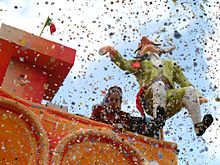
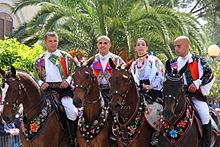
- The Carnival of Mamoiada (Italian: Carnevale di Mamoiada) is "one of the most famous events of Sardinian folklore",[164] which takes place in Mamoiada. His masks are the Mamuthones (men with faces covered in a black mask with rough features, dressed in dark furs and with cowbells hanging from their backs. They make their first appearance on 17 January on the occasion of the feast of St. Anthony, immediately after on the Sunday and Tuesday of the Mamoiadino carnival, and today they are also the attraction of many folk festivals from other countries of the island and around the world)[165][166] and the Issohadores (men dressed in red bodice, white mask, sa berritta (headdress), cartzas (or cartzones, white pants) and s'issalletu (small shawl), who escort the Mamuthones. With laces they capture young women as a sign of good omen for good health and fertility. At one time the landowners were captured to wish them a good year and they, to repay the honor received, took the whole group to their home and offered wine and sweets. Today, attention is often paid to local authorities, but the intent remains unchanged).[165][166]
- The Sartiglia (in Sa Sartiglia) is an equestrian game (equestrian joust) that takes place in Oristano on the last Sunday and Tuesday of Carnival.[167] On Shrove Monday and the following Tuesday, the horsemen in the streets of the historic center of the city of Oristano, at a gallop, must try to spear a suspended silver star with a spear. If the actions are successful and many stars have been engraved, the population believes there will be a good harvest next year. The knights are first dressed in historical costumes. They wear a wedding veil, a top hat and hold a bouquet of violets in their hands. After the carousel of the stars, the participants still compete in horse riding. On Shrove Monday there is a riding tournament for young people, the Sartigliedda.[168]
- The Carnival of Tempio Pausania (Italian: Carnevale di Tempio Pausania), in Gallurese: Carrascialu timpeisu) is the carnival of Tempio Pausania, one of the most famous in Sardinia.[169][170] Its parade of floats has been taking place since 1956.[171] A procession of chariots is opened by Re Giorgio (King George).[171][172] During the carnival he meets and makes friends with a common town, Mannena (usually very succinct). Mannena then "gives" him a son who will be Re Giorgio the following year.[171] At the end of the carnival, the king is judged and then burned (the misfortunes of the past year are attributed to him). The fire here symbolizes the transition from winter to summer.[172]
- The Sardinian Cavalcade (Italian: Cavalcata sarda) is an ancient cultural and traditional event that takes place in Sassari, usually on the penultimate Sunday of May, which consists of the parade on foot, on horseback or on the traccas (the characteristic floats decorated with flowers and everyday objects), of groups from all over Sardinia.[173] Participants wear the characteristic costume of the place of origin, often enriched with well-kept embroideries and filigree jewels. The event continues in the afternoon in the city hippodrome where horses and riders perform in daring pairs and acrobatic figures, to end in the evening in the Piazza d'Italia with traditional Sardinian songs and dances, on the notes of launeddas and accordions, which continue for good part of the night.[173] The first edition of the Cavalcata dates back to 1711, when the Municipal Council of Sassari, at the end of the Spanish domination, decided to "make cavalcata" in homage to King Philip V of Spain.[173]
- The Cortes Apertas (Sardinian for 'Open courtyards') is a cultural event typical of Sardinia and in particular of the province of Nuoro. During the celebrations, the local cultural, productive, culinary and folkloristic realities organize events, tastings and entertainments in the historic centers and inside the historic courtyards of the host municipality.[174] Every week, in a different municipality, the historic houses of the town open their courtyards and between these there is an enogastronomic and artistic journey. Inside the different courtyards traditional crafts are represented, such as wool processing, threshing, cleaning and harvesting wheat, while folkloristic performances of dances and popular songs are set up in the town squares.[175] Over time, the event has become for the municipalities one of the most important events within the tourist season.[175][176]
Sicily
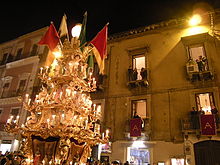
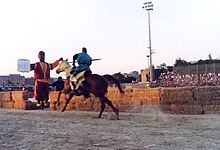
- The George Maniaces as war booty and remained there for 86 years.[181] Sicilians celebrate Saint Agatha for her purported intercession to avert danger during eruptions of Mount Etna, earthquakes, and some epidemics that had affected Catania.[182] There is also an underlying theme of Sicilian resistance to Roman oppression.[183]
- The processione dei Misteri di Trapani or simply the Misteri di Trapani (English: procession of the Mysteries of Trapani, or the Mysteries of Trapani) is a day-long passion procession featuring 20 floats of lifelike sculptures made of wood, canvas and glue. These sculptures are of individual scenes of the events of the Passion, a passion play at the centre and the culmination of the Holy Week in Trapani. The Misteri are amongst the oldest continuously running religious events in Europe, having been played every Good Friday since before the Easter of 1612, and running for at least 16 continuous hours, but occasionally well beyond the 24 hours, are the longest religious festival in Sicily and in Italy.[184]
- The Holy Week in Barcellona Pozzo di Gotto (in Santa Sumana) is a popular religious event typical of the comune of Barcellona Pozzo di Gotto. The event has been included in the register of Intangible Heritage of the Sicilian Region since 20 October 2008.[185]
- The Ballo dei diavoli (English: Devils' dance) is dance of the comune of Prizzi, from the province of Palermo, that is usually danced at Easter.[186] Since the morning of Easter day, two masked devils (dressed in red) and death, dressed in the typical ocher yellow, wander undisturbed through the streets of the town, making jokes and detaining passers-by, who are released only in exchange for an offering (money or sweets). The climax of the event takes place in the afternoon, when the devils try to prevent the meeting, in the main square of the town, between the statues of Christ and Mary. The angels who escort the statues oppose them: it is this contrast, carried out according to precise rhythmic movements, which is called the dance of the devils. Once the devils have been defeated, the risen Christ and the Madonna can finally meet (in Sicilian: U 'ncontru) and Good triumphs over Evil.
- The Saracens in 1071.[188]The Giostra del Saraceno ("Joust of the Saracen") is the highlight of the three days of the Palio. The neighborhoods, from their churches, parade in the early afternoon to go to the Arena. Here the five Knights, each representing a district, compete for the symbolic conquest of the Vessillo ("Banner").
Tuscany
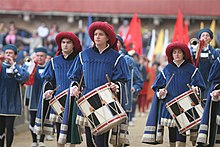
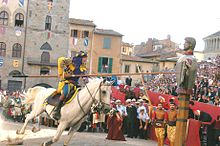
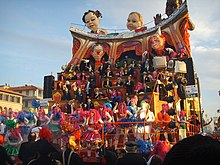
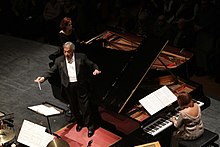
- The Great War. The Corteo Storico, a pageant to the sound of the March of the Palio, precedes the race, which attracts visitors and spectators from around the world. The race itself, in which the jockeys ride bareback, circles the Piazza del Campo, on which a thick layer of earth has been laid. The race is run for three laps of the piazza and usually lasts no more than 90 seconds. It is common for a few of the jockeys to be thrown off their horses while making the treacherous turns in the piazza, and indeed, it is not unusual to see riderless horses finishing the race. The first Palio di Siena took place in 1633.[190]
- The Scoppio del carro (English: Explosion of the cart) is a manifestation of the popular secular-religious tradition that takes place on Easter Sunday in the historic center of Florence. The Brindellone, a pyrotechnic tower positioned on a cart, is pulled by two pairs of oxen and positioned between the Florence Baptistery and the Florence Cathedral. During the initial rites of the Mass on Easter day, at the song of Gloria, the archbishop lights, near the altar of the Cathedral - with the blessed fire during the Easter vigil - a rocket in the shape of a dove which, sliding on an iron wire hoisted 7 meters above the ground, runs through the central nave of the church and reaches the Chariot outside, causing it to burst.[191]
- soccer and rugby) that originated during the Middle Ages in Italy.[192] Once widely played, the sport is thought to have started in the Piazza Santa Croce in Florence. There it became known as the giuoco del calcio fiorentino ("Florentine kick game") or simply calcio, which is now also the name for association football in the Italian language. The game may have started as a revival of the Roman sport of harpastum. This traditional sporting event attracts tourists from all over the world.[193]
- The Saracen Joust (Italian: Giostra del Saracino) of Arezzo is an ancient game of chivalry. It dates back to the Middle Ages. It was born as an exercise for military training. This tournament was regularly held in Arezzo between the 16th century and the end of the 17th century, when memorable jousts in baroque style were organized. The joust – which became a typical tradition of Arezzo at the beginning of the 17th century – declined progressively during the 18th century and eventually disappeared, at least in its "noble" version. After a brief popular revival between the 18th and 19th century, the joust was interrupted after 1810 to reappear only in 1904 in the wake of the Middle Ages reappraisal operated by Romanticism. Finally, the joust was definitely restored in 1931 as a form of historical re-enactment set in the 14th century, and quickly acquired a competitive character. Saracen Joust attracts tourists from all over the world.[194]
- The Carnival of Viareggio (Italian: Carnevale di Viareggio) is a carnival event annually held in the Tuscan city of Viareggio, in Italy. It is considered amongst the most renowned carnival celebrations in both Italy and Europe. Its main characteristic is given by the parade of floats and masks, usually made of paper-pulp, depicting caricatures of popular people, such as politicians, showmen and sportsmen; the parade is held on the Viareggio avenue located alongside the local beach. Every year, the Carnevale di Viareggio attracts more than 500,000 spectators.[195]
- The Carnival of Foiano della Chiana (Italian: Carnevale di Foiano della Chiana) is an event that takes place annually in Foiano della Chiana, in the province of Arezzo. It is one of the most famous and ancient Italian carnivals, having been found documents dating back to the edition of 1539.[196] The four Cantieri (Azzurri, Bombolo, Nottambuli and Rustici) in which the city population is divided participate in the Foiano Carnival. These, during the year, each work on an allegorical float, trying to make it better than the others. The winner wins the Carnival Cup.
- The Maggio Musicale Fiorentino (English: Florence Musical May) is an annual Italian arts festival in Florence, including a notable opera festival, under the auspices of the Opera di Firenze. The festival occurs between late April into June annually, typically with four operas. In April 1933, on Luigi Ridolfi Vay da Verrazzano's idea, Vittorio Gui founded the festival, with the aim of presenting contemporary and forgotten operas in visually dramatic productions. It was the oldest music festival in Italy and the oldest in Europe after the Salzburg Festival.[189] The first opera presented was Verdi's early Nabucco, his early operas then being rarely staged.
- The Bravio delle botti (English: Bravio of the barrels) is an annual race held in the Italian town of Montepulciano since 1974, replacing an equivalent horserace dating back to 1373. Teams of two runners (spingitori) representing the eight districts of the town (contrade) compete to be the first to roll an 80 kg wine barrel through the streets of the historic centre from the Colonna del Marzocco to the finish on the Piazza Grande, the cathedral square.[197]
- The Diotto is the celebration for the anniversary of the founding of Scarperia, held each year on 8 September. The name itself recalls the date: dì as for "day" and otto which means "eight". Actually, the founding began September the 7th 1306, but it was decided that the anniversary date should have been the day after, birth of the Virgin Mary.[198] The celebration is a historical reenactment made up of a pageant from Florence and Scarperia, and a competition called Palio, which designate both the event and the prize.
Trentino-Alto Adige
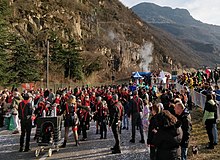
- The Trentino-Alto Adige;[199][200] is held in Laives and Bolzano in the two weekends preceding Shrove Tuesday. The main event is the parade of floats that takes place in Laives on the Sunday before Shrove Thursday and is repeated in Bolzano the following Saturday.[201] The event has been organized annually since 1978.[202]
- The Alto Adige, particularly felt in the villages of Termeno sulla Strada del Vino and Salorno. It takes place on Shrove Tuesday in odd years. The first trace dates back to 1591.[203] The parade is opened by a trumpeter followed by peasants on horseback, others with whips (Ausschnöller) and some small streets with the important task of keeping the road ahead clean and free. Following, each on their own cart, there are peasants, agricultural laborers, poor people, gypsies, rich people, tailors, fishermen, etc., with a cart that symbolically represents the seeds.[204]
Umbria
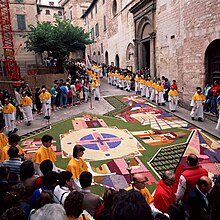
- The Roman military camps, where the soldiers were trained in lance fighting.[205] This is the origin of the tournament's name, but the first definition and documented "Quintana" as a knights' jousting tournament during a festival, dates back to 1448. In 1613 the build-up to the Quintana tournament included the carnival festivals seen today. Giostra della Quintana attracts tourists from all over the world.[206]
- Saint Anthony, in order. They are mounted upon immense wooden pedestals each hoisted by a team of "Ceraioli" (runners) clad respectively in yellow, blue, or black.
- The Corpus Domini feast, on the ninth Sunday after Easter. On that night, almost a thousand people work incessantly to create carpets and pictures made of flowers along the town's narrow streets. Floral creations cover streets throughout the historical centre in preparation for the passage of the Blessed Sacrament carried in procession by the bishop on Sunday morning.[209]
Veneto

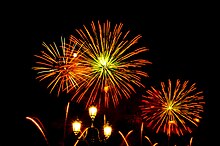

- The San Marco Square. Apparently, this festival started in that period and became official during the Renaissance.[211] In the 17th century, the baroque carnival preserved the prestigious image of Venice in the world.[212] It was very famous during the 18th century.[213] It encouraged licence and pleasure, but it was also used to protect Venetians from present and future anguish.[214] However, under the rule of the Holy Roman Emperor and later Emperor of Austria, Francis II, the festival was outlawed entirely in 1797 and the use of masks became strictly forbidden. It reappeared gradually in the 19th century, but only for short periods and above all for private feasts, where it became an occasion for artistic creations.[215] After a long absence, the Carnival returned in 1979.[216]
- The Saint Mark's Basilica.[222]
- The Saint Mark's basin begins to fill with up with boats of all kinds, festooned with balloons and garlands,[225] and thousands of Venetians await the fireworks while dining on the boats. A bridge of barges is built connecting Giudecca to the rest of Venice.[226] From 1950 to 2000 the bridge was built by the Italian Army's 2nd Pontieri Engineer Regiment.[227]
- The Venice Lagoon. Screenings take place in the historic Palazzo del Cinema on the Lungomare Marconi. The festival continues to be one of the world's most popular and fastest-growing.[231]
See also
Notes
- kalends of October, that is 19 September.[93]
References
- ^ a b "The Best Christmas Traditions in Italy". Walks of Italy. 25 November 2013. Retrieved 26 January 2021.
- ^ "Natale, origine del nome". Etimo Italiano (in Italian). Archived from the original on 8 December 2015. Retrieved 26 January 2021.
- ^ "Natale (italienische Weihnachten)". Mein Italien (in German). Archived from the original on 28 April 2009. Retrieved 26 January 2021.
- ^ ISBN 978-0-313-34080-2.
He was responsible for staging the first living Nativity scene or creche, in Christian history; and he was also Christianity's first stigmatic. He shares the honor of being patron saint of Italy with Saint Catherine of Siena. His feast day is celbrated on October 4, the day of his death; many churches, including the Anglican, Lutheran, and Episcopal churches, commemorate this with the blessing of the animals.
- ^ Dues, Greg.Catholic Customs and Traditions: A Popular Guide Twenty-Third Publications, 2000.
- ^ Thomas, George F.. Vitality of the Christian Tradition. Ayer Co. Publishing, 1944.
- ^ "#MyLivingNativity". Upper Room Books. Archived from the original on 7 November 2021. Retrieved 31 October 2018.
- ^ St. Bonaventure. "The Life of St. Francis of Assisi". e-Catholic 2000. Archived from the original on 14 June 2014. Retrieved 28 September 2013.
- ISBN 0-310-24880-9p.47.
- ^ "Most people in a nativity scene: Welton Baptist Church sets world record". worldrecordacademy.com. 4 December 2011. Archived from the original on 4 March 2016. Retrieved 6 January 2015.
- ^ "Celebrate Christmas Italian Styles at These City Events". TripSavvy. Retrieved 26 January 2021.
- ^ a b "Mercatini di Natale a Bologna e in Emilia-Romagna: dove sono e le regole per visitarli" (in Italian). Retrieved 1 December 2021.
- ^ a b "30 anni e non sentirli" (in Italian). Retrieved 1 December 2021.
- ^ a b "Mercatini originali Alto Adige - Südtirol" (in Italian). Retrieved 5 December 2021.
- ^ a b "Mercatini di Natale di Trento" (in Italian). Retrieved 5 December 2021.
- ^ a b "San Gregorio Armeno, la via dei Presepi" (in Italian). Retrieved 5 December 2021.
- ^ "Il Mercatino di Natale a piazza Navona" (in Italian). Retrieved 30 January 2024.
- ^ "I MERCATINI DI NATALE PIÙ BELLI IN ITALIA" (in Italian). Retrieved 6 February 2024.
- ^ "Alla scoperta dei 10 mercatini di Natale più belli d'Italia" (in Italian). Retrieved 6 February 2024.
- ^ "Mercatini di Natale 2023: la nostra wishlist" (in Italian). Retrieved 6 February 2024.
- ^ a b "Mein Italien – Zampognari". www.mein-italien.info. Retrieved 26 January 2021.
- . Retrieved 26 January 2021.
- ^ "La storia della Befana". Festa della Befana (in Italian). Retrieved 26 January 2021.
- ^ "La triade golosa del Natale italiano: cappone, abbacchio e capitone". lacucinaitaliana.it (in Italian). Retrieved 26 December 2022.
- ^ "Food: Italian Christmas Eve Fish Dinner". Sicilian Culture. 25 December 2002. Archived from the original on 11 September 2012. Retrieved 22 December 2011.
- ^ "Easter: How does Italy celebrate this festivity?". Retrieved 6 January 2024.
- ^ "Abbacchio Romano IGP". abbacchioromanoigp.it. Archived from the original on 14 July 2014. Retrieved 10 June 2014.
- ^ "abbàcchio". Vocabolario – Treccani. Retrieved 15 January 2016.
- ^ "Abbacchio Romano IGP" (in Italian). qualigeo.eu. Retrieved 7 January 2024.
- ^ a b "Osservatorio sulla spesa di Roma" (PDF) (in Italian). Retrieved 8 January 2024.
- ^ a b "Il simbolismo dell'agnello pasquale". lacucinaitaliana.it (in Italian). Retrieved 26 December 2022.
- ^ "La Sacra Bibbia" (in Italian). Retrieved 26 December 2022.
- ^ a b c d e f g h i Toschi, Paolo (1967). Conosci l'Italia (volume XI), Il Folklore (in Italian). Touring Club Italiano. pp. 36–37.
- ^ a b "Cavallo di fuoco" (in Italian). Retrieved 24 March 2018.
- ^ Il Messaggero, ed. Marche, 11 April 2007.
- ^ "Capodanno, dalle lenticchie alla mutande rosse, ecco tutti i riti della notte di San Silvestro" (in Italian). Retrieved 30 October 2022.
- ^ "Ultima notte dell'anno, ecco i riti scaramantici più celebri a San Silvestro" (in Italian). Retrieved 30 October 2022.
- ^ "Come si "misura" il messaggio di fine anno del presidente della repubblica?" (in Italian). Retrieved 30 October 2022.
- ^ "Lenticchie San Silvestro - perché si mangiano all'ultima notte dell'anno" (in Italian). Retrieved 30 October 2022.
- ^ "Festività nazionali in Italia" (in Italian). Italian Embassy in London. Archived from the original on 24 June 2012. Retrieved 15 April 2012.
- ^ Davis, Robert Charles; Marvin, Garry (2004). Venice, the Tourist Maze. University of California Press. p. 247.
- ^ a b "Sagra" (in Italian). Retrieved 27 October 2022.
- ISBN 9781902669144.
- ^ "SPORT DAL MEDIOEVO" (in Italian). Retrieved 4 April 2022.
- ^ "Il Palio di Siena tra luci e ombre" (in Italian). Retrieved 4 April 2022.
- ^ "Presepe napoletano, la storia. Quali sono i personaggi e che significano". Positanonews (in Italian). Retrieved 26 January 2021.
- ^ "La barca di san Pietro". provincia.padova.it. Archived from the original on 27 September 2007. Retrieved 3 July 2020.
- ^ "La barca di san Pietro, simpatica tradizione da riscoprire". milanofree.it. Retrieved 3 July 2020.
- ^ Biagioli, Francesca (27 June 2017). "La bellissima tradizione della barca di San Pietro, tra leggenda e realtà (FOTO)" (in Italian). greenme.it. Retrieved 3 July 2020.
- ^ "La Madonna della Salute e il Sotoportego de la Peste col masegno rosso dove..." (in Italian). Retrieved 24 October 2022.
- ^ "Dal sito del Comune di Venezia" (in Italian). Archived from the original on 8 June 2010. Retrieved 18 March 2010.
- ^ "Santuario Madonna della Salute". Retrieved 29 May 2022.
- ^ a b "Da centosessantasei anni Gonnosfanadiga festeggia la Madonna della salute" (in Italian). Retrieved 29 May 2022.
- ^ "Manifestazioni" (in Italian). Retrieved 29 May 2022.
- ^ "Festa della Madonna della Salute". Retrieved 29 May 2022.
- ^ "Nel Cuore Del Biellese, Una Processione Per Due Parchi" (in Italian). Retrieved 20 October 2022.
- ISBN 9788836525706. Retrieved 20 February 2018.
- ^ "Procession d'Oropa" (in French). Archived from the original on 21 February 2018. Retrieved 20 February 2018.
- ^ "Processione da Fontainemore a Oropa" (in Italian). 2 August 2010. Retrieved 20 February 2018.
- ^ "Genova vince la 67esima regata storica delle Repubbliche Marinare" (in Italian). Retrieved 9 October 2022.
- ^ a b "Torna ad Amalfi la Regata storica delle antiche Repubbliche Marinare" (in Italian). Retrieved 25 October 2022.
- ^ "La storia dello stivale gareggia sull'acqua: la regata delle Repubbliche Marinare" (in Italian). Retrieved 25 October 2022.
- ^ "Festività e giornate nazionali § Le solennità civili" (in Italian). Governo Italiano - Dipartimento per il Cerimoniale dello Stato. Retrieved 1 March 2022.
- ^ Scaramuzzino, Maria (29 June 2020). "Peter and Paul, the patron saints of Rome, the Eternal City". italiani.it. Retrieved 11 May 2021.
- Times Literary Supplement. Oxford University Press. 1968. pp. 172–183.
- ^ Riti e leggende di Calendimaggio. La Domenica del Corriere (in Italian). 1926.
- ^ ISBN 9788852059629.
- ^ "Le feste nella Firenze del Rinascimento (Prima parte)" (in Italian). Retrieved 27 October 2022.
- ^ "Le ceneri del Battista" (in Italian). Retrieved 27 October 2022.
- ^ "La Perdonanza Celestiniana". comune.laquila.it.
- ^ "Perdonanza patrimonio d'Italia per la tradizione". www.chiesadilaquila.it. 26 July 2011.
- ^ "Thirty five new elements inscribed on the Representative List of the Intangible Cultural Heritage of Humanity". ich.unesco.org. 13 December 2019.
- ^ Grant, Richard (4 February 2016). "Italy's fascinating Festival of the Snake-Catchers". The Telegraph. Retrieved 1 May 2018.
- ^ Pecoraro, Emiliano (October 2018). "La festa dei serpari: tra antropologia, arte, religione e mito" (PDF). Retrieved 8 February 2020.
- ^ "Saper far turismo, la Notte della Taranta costa uno e rende tre" (in Italian). Retrieved 19 October 2022.
- ^ "Notte della Taranta 2022, la festa dei 200mila arriva in tv: la scaletta" (in Italian). Retrieved 19 October 2022.
- ^ Di Palo, Francesco (1999). I Giorni del Sacro (in Italian). Terlizzi: Centro Stampa Litografica. p. 6.
- ^ "Matera, Patrimonio Mondiale dell'Umanità" (in Italian). Retrieved 19 October 2022.
- ^ "Matera, cosa fare in 2 giorni tra Sassi e relax" (in Italian). Retrieved 19 October 2022.
- ^ a b "Carnevale 2017 in Italia: eventi e feste più belle a febbraio, da Venezia a Milano". Investireoggi (in Italian). 5 February 2017. Retrieved 28 February 2017.
- ^ a b "Carnevale di Satriano: qui gli alberi sanno passeggiare". TGCOM24 (in Italian). 22 February 2017. Retrieved 28 February 2017.
- ^ "The Rumita and the walking forest". Italia. February 2017. Retrieved 28 February 2017.
- ^ "Caligiuri scrive ai sindaci: "La Processione della Varia di Palmi festa della Calabria"" (in Italian). Retrieved 2 August 2014.
- ^ "Riconoscimento UNESCO: Un Po' Di Informazioni Sulla Rete Italiana Delle Grandi Macchine a Spalla" (in Italian). Retrieved 2 August 2014.
- ISBN 88-365-1256-9.
- ^ ""Meraviglia Italiana" - La Varia di Palmi" (in Italian). Retrieved 12 April 2013.
- ^ "Madonna delle Galline 2009 - Deposizione delle tammorre". YouTube. Retrieved 17 May 2022.
- ^ Dubecki, Larissa (21 April 2009). "Espresso: Coffee goodness". The Age. Retrieved 28 March 2013.
- ^ Zhuk, Alyona (21 February 2012). "Free coffee, anyone?". The Sofia Echo. Retrieved 28 March 2013.
- ^ Croce, Benedetto (1953). "Piedigrotta". Aneddoti di varia letteratura (in Italian). Vol. II. Laterza. pp. 255–258.
- ^ Scialo, Pasquale (1998). La canzona napoletana (in Italian). Newton&Compton. pp. 28–31.
- ^ "San Gennaro – The Patron Saint of Naples and Little Italy, NYC". Archived from the original on 25 February 2009. Retrieved 4 October 2022.
- ^ O'Connell, John (1962). "19 September". The Roman Martyrology.
- ISBN 88-209-7210-7..
- ^ "About San Gennaro". Feast of San Gennaro. Archived from the original on 15 January 2013. Retrieved 4 October 2022.
- ^ Napoli, Comune di. "Comune di Napoli – Il ritorno della Festa di San Gennaro". comune.napoli.it. Archived from the original on 4 November 2016. Retrieved 4 October 2022.
- ^ "sangennaro.org". Archived from the original on 3 November 2016. Retrieved 4 October 2022.
- ^ "Cavalli, asine, fantini e sbandieratori:a Ferrara il Palio più antico del mondo". la Repubblica. 27 May 2013.
- ^ Tumiati, Gaetano (1994). "Il Palio: fastosa imitazione". Archived from the original on 27 November 2020.
- ^ De Vincentis, Stefania. "Il Palio di Ferrara - MuseoFerrara". www.museoferrara.it.
- ISBN 978-88-6462-005-3.
- ^ "La storia del carnevale di Cento" (in Italian). Archived from the original on 16 April 2012. Retrieved 22 October 2022.
- ^ "Palio dello Scarlatto" (in Italian). Retrieved 9 October 2022.
- ^ a b "Lo storico Palio dello Scarlatto" (in Italian). Archived from the original on 19 April 2012. Retrieved 9 October 2022.
- ^ "Cenni" (in Italian). Retrieved 9 October 2022.
- ^ "Cenni storici dello Scarlatto" (in Italian). Archived from the original on 23 August 2010. Retrieved 9 October 2022.
- ^ "Barcolana, the largest regatta in the world is presented in London". Retrieved 29 October 2022.
- ^ "Barcolana 54, l'Albo d'Oro" (in Italian). Retrieved 9 October 2022.
- ^ "Eventi a Roma: Una delle feste più amate dai romani: la Befana" (in Italian). Retrieved 19 October 2022.
- ISBN 88-541-0304-7.
- ISBN 88-541-0304-7.
- ^ "Maschere romanesche" (in Italian). Retrieved 22 October 2022.
- ^ "Festa de' Noantri 2022" (in Italian). Retrieved 22 October 2022.
- ^ Fagiolo dell'Arco, Maurizio; Petrucci, Francesco (1998). Gian Lorenzo Bernini nell'infiorata di Genzano. 1598-1998 (in Italian). Arti Grafiche. pp. 13–28.
- ^ Fagiolo dell'Arco, Maurizio; Carandini, Silvia (1977–1978). L'effimero barocco: strutture della festa nella Roma del '600 (in Italian). Bulzoni.
- ^ "La Macchina di Santa Rosa" (in Italian). Retrieved 29 October 2022.
- ^ "Palio of the Gulf: pride & tradition" (in Italian). Retrieved 22 October 2022.
- ^ "Genova, alla Foce ritorna il Palio Marinaro di San Pietro: sfida in mare tra gli storici rioni della città". ilsecoloxix.it. ilsecoloxix.it. 1 July 2022. Retrieved 2 July 2022.
- ^ "La Scala di Milano ha compiuto 243 anni: è tra i teatri più prestigiosi al mondo" (in Italian). Retrieved 8 December 2022.
- ^ "Les Walser dans l'histoire des Alpes: Réflexions en marge d'une lecture" (in French). Retrieved 23 October 2022.
- ^ "Les festivités carnavalesques ont commencé — " Rabadan " tessinois" (in French). Retrieved 23 October 2022.
- ISBN 2-02-009763-X. Retrieved 23 October 2022.
- ^ "Oh Bej! Oh Bej! Fair". Retrieved 29 October 2022.
- ^ "Italian traditions: Buon Sant'Ambrogio and O'Bej O'Bej". Retrieved 29 October 2022.
- ^ a b c Fiera del Tredesin de Mars Archived 2013-02-26 at the Wayback Machine
- ^ "El Tredesin de Marz" (in Italian). Retrieved 29 October 2022.
- ^ "El Tredesin de Mars" (in Italian). Retrieved 29 October 2022.
- ^ "Il Palio di Legnano" (in Italian). Archived from the original on 24 March 2016. Retrieved 29 October 2022.
- ^ "Il Palio tra folklore e storia" (in Italian). Archived from the original on 30 March 2014. Retrieved 29 October 2022.
- ^ "Newsletter del Comune di Legnano" (in Italian). Retrieved 29 October 2022.
- ^ "Da "Varese News" - La "Fabbrica del Canto"" (in Italian). Retrieved 29 October 2022.
- ^ "Festa della Lombardia" (in Italian). Archived from the original on 24 September 2015. Retrieved 29 October 2022.
- ^ a b c "Teatro alla Scala Première 2022, Great Opening Night". Retrieved 8 December 2022.
- ^ "Prima della Scala: doppia ovazione per l'opera e per il presidente Mattarella. "Debutto" per Meloni" (in Italian). Retrieved 8 December 2022.
- ^ "La storia del Teatro alla Scala" (in Italian). Archived from the original on 1 April 2013. Retrieved 7 September 2012.
- ^ "È anche la "prima" di Maria Callas: un trionfo" (in Italian). Retrieved 8 December 2022.
- ISBN 978-8817023870.
- ^ "Teatro alla Scala: il Don Carlo apre la stagione. Anteprima il 4 dicembre" (in Italian). Retrieved 8 December 2022.
- ^ "Prima della Scala: standing ovation di 13 minuti per il 'Godunov'. Cinque minuti di applausi per Mattarella nel palco con Von der Leyen" (in Italian). Retrieved 9 December 2022.
- ^ Berardi, Alberto; Piccinetti, Pierluigi. Il pupo 50 anni di storia (in Italian). pp. 2–4.
- ^ Ente manifestazioni Fano. Carnevale di Fano: bello da vedere dolce da gustare (in Italian). p. 11.
- ^ "Carnevale di Fano_sito ufficiale" (in Italian). Retrieved 23 October 2022.
- ^ Alighieri, Dante (1817). "Purgatorio, canto V, 64-108". Divina Commedia.
- ^ Manna, Raffaella; Pelosi, Federica. Fucci e il Carnevale (in Italian). p. 7.
- ^ Ente manifestazioni Fano. Carnevale di Fano:bello da vedere dolce da gustare (in Italian). p. 11.
- ^ Carol Glatz (Catholic News Service) (31 October 2019). "Pope adds feast of Our Lady of Loreto to universal calendar". Catholic News Herald (online edition). Charlotte, North Carolina. Retrieved 19 January 2020.
- ^ "Il Falò per la Venuta - Pellegrinaggio a Piedi Macerata - Loreto" (in Italian). Retrieved 21 September 2021.
- ^ Almagià, Roberto (1961). Le regioni d'Italia (in Italian). Vol. X. UTET. p. 314.
- ^ Tradizioni e costumi d'Italia (in Italian). Novara: Istituto geografico De Agostini. 1983. pp. 343 and 356.
- ^ "Fuochi della Venuta" (in Italian). Archived from the original on 16 September 2017. Retrieved 29 October 2022.
- ^ Tuttitalia, enciclopedia dell'Italia antica e moderna (in Italian). Vol. Marche. Istituto geografico De Agostini e Casa editrice Sansoni. 1963. p. 70.
- ^ Leonardo Delle Noci. "Quintana di Ascoli" (in Italian). Retrieved 3 March 2020..
- ISBN 0-313-30733-4.
- ISBN 88-7938-273-X.
- ^ a b "Italy's Biggest Battle of the Oranges". Der Spiegel. 8 June 2008. Archived from the original on 29 March 2010. Retrieved 15 February 2010.
- ^ "Battle of Oranges at Italian carnival". Odopo. 16 January 2007. Archived from the original on 26 July 2011. Retrieved 15 February 2010.
- ^ "The Carnival of Ivrea: Sights & Activities". Italy Traveller. Archived from the original on 12 October 2008. Retrieved 19 July 2009.
- ISBN 978-90-18-01951-8.
- ^ Kiefer, Peter (19 February 2007). "In Italian town, civics lesson from annual orange battles". The New York Times. Retrieved 19 July 2009.
- ISBN 978-1-74104-303-7.
- ^ Gentile, L. (1928). Le antiche feste Patronali di San Secondo in Asti, Rievocazioni storiche. p. 5.
- ^ Ventura G., Memoriale (Capitolo X)
- ^ "Sampeyre, 2012 – "Baìo" returns" (Web page). piemonteitalia.eu. Piemonte Italia. 9 February 2012. Retrieved 1 April 2012.
- ^ "Italica RAI" (in Italian). Archived from the original on 17 January 2014. Retrieved 16 February 2013.
- ^ a b Marchi, Raffaello (1951). "Le maschere barbaricine". Il Ponte (in Italian). Vol. VII. pp. 1354–1361.
- ^ a b Angioni, Giulio. sagre, riti e feste popolari della Sardegna (in Italian). Newton Compton.
- ^ "Il fascino della Sartiglia di Sardegna" (in Italian). Retrieved 23 October 2022.
- ^ "Ahoi! Alaaf! Helau! Karneval auf Sardinien: Sa Sartiglia in Oristano" (in Italian). Archived from the original on 22 January 2012. Retrieved 23 October 2022.
- ^ "Carnaval de Tempio Pausania" (in French). Retrieved 23 October 2022.
- ISBN 978-2-7469-3017-9.
- ^ a b "Le Carnaval de Tempio Pausania" (in French). Retrieved 23 October 2022..
- ^ a b c "Cavalcata Sarda" (in Italian). Retrieved 24 October 2022.
- ^ "Eventi in Sardegna, scopriamo le Cortes Apertas" (in Italian). Retrieved 18 August 2022.
- ^ a b "Cortes Apertas, l'ostentazione della tradizione e dell'identità" (in Italian). Retrieved 29 October 2022.
- ^ "Ennesimo successo di Cortes apertas Putzu: "Altro che modello superato"" (in Italian). Retrieved 29 October 2022.
- ^ "La festa di S. Agata, Bianco: "Ho proposto di riaprire, dopo le festività, il sacello" – Ultima TV" (in Italian). Retrieved 5 February 2017.
- ^ "S. Agata minuto per minuto" (in Italian). Archived from the original on 6 February 2017. Retrieved 5 February 2017.
- ^ "Sant'Agata, il programma della Festa e delle processioni dal 3 al 5 febbraio - QdS.it" (in Italian). Archived from the original on 5 February 2017. Retrieved 5 February 2017.
- ^ Giuseppe Pitrè (1900). Feste patronali in Sicilia (in Italian). Carlo Clausen. p. XXXII.
- ^ Giuseppe Pitrè (1900). Feste patronali in Sicilia (in Italian). Carlo Clausen. p. 217.
- ^ "Feast of Sant'Agata in Catania". Retrieved 29 October 2022.
- ^ "Festa di Sant'Agata: Celebrate Street Food in Catania". Retrieved 29 October 2022.
- ^ "Trapani and Its Mysteries". Italian Tourism Official Website. 23 March 2015.
- ^ "Registro Eredità Immateriali" (in Italian). Archived from the original on 16 April 2017. Retrieved 15 April 2017..
- ISBN 978-88-7009-826-6.
- ^ "Le Palio des Normands" (in French). Retrieved 29 October 2014.
- ^ "Palio des Normands à Piazza Armerina" (in French). Retrieved 29 October 2014.
- ^ a b "PERCHÉ IL MAGGIO È IL MAGGIO?" (in Italian). Retrieved 26 October 2022.
- ^ "The Palio Horse Race - All the victories at the Palio di Siena from 1633 to 1691". Ilpalio.org. Retrieved 15 September 2016.
- ^ "Il Brindellone. La storia vera dello scoppio del carro a Firenze" (in Italian). Retrieved 19 October 2022.
- ISBN 978-8885559707.
- ^ "Muscoli, sudore e sabbia, ora il calcio storico sbarca in diretta su Dazn" (in Italian). Retrieved 2 October 2022.
- ^ "Feste e manifestazioni ad Arezzo" (in Italian). Retrieved 2 October 2022.
- ^ "Kinder torna al Carnevale di Viareggio" (in Italian). Retrieved 25 October 2022.
- ^ "Al Carnevale" (in Italian). Archived from the original on 1 May 2008. Retrieved 28 January 2009.
- ^ "Bravìo delle Botti di Montepulciano" (in Italian). Retrieved 27 October 2022.
- ^ "Cos'è il "Diotto"" [What is the Diotto] (in Italian). Retrieved 8 August 2022.
- ^ "Laives, carnevale tra le meraviglie italiane" (in Italian). Retrieved 6 February 2018.
- ^ "Sfilata di Carnevale, per un giorno Laives è la capitale regionale" (in Italian). Retrieved 6 February 2018.
- ^ "Presentata la 40ª edizione del Carnevale di Laives, 10 giorni di festa" (in Italian). Archived from the original on 7 February 2018. Retrieved 6 February 2018.
- ^ "Storia del Carnevale" (in Italian). Archived from the original on 7 February 2018. Retrieved 6 February 2018.
- ^ "Dati storici" (in Italian). Retrieved 29 October 2022.
- ^ "Descrizione del corteo e dei principali personaggi" (in Italian). Retrieved 29 October 2022.
- ^ a b "Una giostra al centro del mondo" (in Italian). Retrieved 10 October 2022.
- ^ "Boom di presenze" (in Italian). Retrieved 10 October 2022.
- ^ "Festa dei Ceri and Corsa dei Ceri". Bella Umbria – tourism information.
- ^ "Festa dei Ceri a Jessup" (in Italian). Retrieved 26 October 2022.
- ^ "Infiorate di Spello" (in Italian). Retrieved 26 October 2022.
- ^ a b Anderson, Ariston (24 July 2014). "Venice: David Gordon Green's 'Manglehorn,' Abel Ferrara's 'Pasolini' in Competition Lineup". The Hollywood Reporter. Retrieved 9 September 2018.
- ^ Reato, Danilo (1988). Storia del carnivale di Venezia (in Italian). Assessorato alla Cultura della Provincia di Venezia.
- ^ Bertrand, Gilles (2013). Histoire du carnaval de Venise, XIe-XXIe siècle (in French). Pigmalion. pp. 37–94.
- ^ Bertelli, Stefania (1992). Il Carnivale di Venezia nel Settecento (in Italian). Jouvence.
- ^ Johnson, James (2011). Venice incognito: masks in the Serene Republic. University of California Press. pp. 95–235.
- ^ Bertrand, Gilles (2013). Histoire du carnaval de Venise, XIe-XXIe siècle (in French). Pigmalion. pp. 237–310.
- ^ Bressanello, Alessandro (2010). Il carnivale in età moderna: 30 agni di carnivale a Venezia 1980-2010. Studio LT2..
- ^ Académie des beaux-arts (1864). Dictionnaire de l'Académie des beaux-arts [Dictionary of the Academy of Fine Arts] (in French). Vol. 2. p. 393.
- ^ "Mille ans d'Histoire" [A thousand years of history]. UNESCO (in French). 2007. Retrieved 18 May 2022.
- ^ Eschner, Kat (26 May 2017). "Venice Has Been Married to the Sea for Over a Thousand Years". Smithsonian Magazine. Retrieved 18 May 2022.
- ISBN 9781409366461.
- ^ "Everything you need to know about La Festa della Sensa, the day Venice celebrates its union with the sea". Venezia Autentica.
- ISBN 9788790493646.
- ^ a b "The Redentore Feast-day: July 19-20, 2008". City of Venice. Retrieved 16 July 2008.
- ^ "The vow". City of Venice. Retrieved 16 July 2008.
- ^ "The Redentore today". City of Venice. Retrieved 16 July 2008.
- ISBN 1-74104-303-4.
- ^ "La Storia del 2° Reggimento Genio Pontieri". Associazione Nazionale Genieri e Trasmettitori d'Italia. Retrieved 5 December 2019.
- ISBN 9781317267218.
- ^ "Addio, Lido: Last Postcards from the Venice Film Festival". Time. Retrieved 9 September 2018.
- ^ "50 unmissable film festivals". Variety. 8 September 2007. Retrieved 23 June 2020.
- S2CID 143590320.

